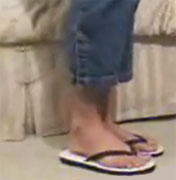
FRIDAY, May 31 (HealthDay News) — From poolside to an evening out on the town, for many people, flip-flops have become a summer staple. This popular style of footwear, however, may not be the best choice for every situation, an expert warns.
“While flip-flops are perfectly fine — and far better than going barefoot — in a number of settings, they do have some drawbacks,” said Dr. Christina Sigur, a podiatrist and instructor in orthopedics at Wake Forest Baptist Medical Center.
“They really don’t offer too much support or protection. Wearing them too often or for certain intensive activities can lead to a variety of foot problems,” she explained in a Wake Forest news release.
The American Podiatric Medical Association offers these flip-flop safety tips:
- Look for leather. Flip-flops made of high-quality leather are less likely to cause blisters and other types of irritation.
- Sturdy is better. Avoid flimsy flip-flops that you can bend in half. Instead, opt for a pair that bends at the ball of the foot. This is particularly important when you are at the beach, in hotel rooms or locker room areas and walking around a public pool.
- Consider fit. Your foot should not hang off the edge of the flip-flop.
- Watch for signs of wear. It’s not a good idea to wear the same pair of flip-flops year after year. Once they show significant signs of wear, it’s time to get a new pair.
- Pay attention to your feet. Do not ignore irritation between toes, which can lead to blisters and possible infections.
The American Podiatric Medical Association noted that flip-flops are not appropriate footwear for all situations. The group advised that people not wear flip-flops when walking long distances, doing yard work or playing sports because these shoes do not offer much shock absorption or arch support, and they do not fully protect the feet.
“I specialize in foot and ankle medicine and surgery, and prevention is a big part of my practice,” Sigur noted. “When it comes to flip-flops, all it really takes is a little common sense to avoid injuries.”
More information
The American Podiatric Medical Association provides more flip-flop safety tips.

